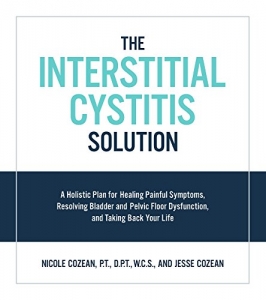Written by Nicole and Jesse Cozean, the Interstitial Cystitis Solution is the best book written about interstitial cystitis in twenty years. If you are newly diagnosed with IC/BPS, it will give you a road map on how to approach your treatment and self care. If you’re a grizzled IC veteran, it provides the latest information about why IC symptoms often persist and how you can find relief. It may also challenge everything that you believe about IC.
Twenty years ago, IC treatment focused on repairing a damaged bladder wall. In 2017, we now understand that many of the urinary symptoms that IC and chronic prostatitis patients experience may originate from and/or be exacerbated by dysfunctional pelvic floor muscles and/or nerves. The authors wrote “The bladder doesn’t live in isolation. It’s intricately connected with all the muscles, ligaments and tissue that surround it, collectively known as the pelvic floor.”
While the initial cause and/or injury may be different in patients, the Cozean’s explain that many patients end up caught in a vicious cycle of bladder dysfunction, muscle tension, inflammation, pain and nerve up-regulation that leads to the chronic bladder symptoms we know as IC. They said “muscle tightness amplifies and contributes to pain and urinary symptoms.” They offer a three stage recovery plan that focuses on restoring muscle function and blood flow, as well as calming the nerves, reducing inflammation and treating pain.
 The best parts of this book are the two chapters which discuss the anatomy of the pelvic floor and how physical therapy should be conducted. Did you know, for example, that if urethral sphincter muscles are tight they can cause an urgent need to urinate, burning pain in the urethra or the stinging that might occur during urination? That three specific muscles can directly cause bladder and urethral symptoms while other muscles cause the pain that you might experience while driving, sitting or during intimacy. It’s an eye opening journey into the anatomy and complexity of the pelvic floor. They are way more important and influential to bladder function than you (and your physicians) may realize.
The best parts of this book are the two chapters which discuss the anatomy of the pelvic floor and how physical therapy should be conducted. Did you know, for example, that if urethral sphincter muscles are tight they can cause an urgent need to urinate, burning pain in the urethra or the stinging that might occur during urination? That three specific muscles can directly cause bladder and urethral symptoms while other muscles cause the pain that you might experience while driving, sitting or during intimacy. It’s an eye opening journey into the anatomy and complexity of the pelvic floor. They are way more important and influential to bladder function than you (and your physicians) may realize.
Their discussion of pelvic floor physical therapy is outstanding. In 2001, the first study of PT and IC showed that 70% of patients responded to therapy with a greater than 50% improvement of their symptoms. A few years later, another study found that 90% of participants experienced an improvement in their symptoms. Men with chronic prostatitis also responded very favorably to physical therapy. It took large NIH studies in 2009 and 2012 to convince the urology community as a whole that physical therapy not only works but works better than many traditional therapies.
The Cozean’s explain that many physicians and physical therapists haven’t had any training in pelvic floor anatomy and therapy. Patients too may not believe that their symptoms are coming from somewhere other than their bladder or may find the concept of physical therapy “down there” off putting. They wrote “If your physical therapist can recreate any of your urinary or pain symptoms by touching a muscle in your pelvic floor, then that is something that can be treated.”
Lead author Nicole Cozen PT, DPT and WCS has an impressive array of credentials. She’s has a doctorate in physical therapy and is one of 275 certified women’s care specialists in the USA. This very rare specialty required extensive training in the pelvic floor anatomy and function. At her Southern California clinic, Pelvic Sanity, she specializes in the treatment of pelvic pain in men and women. She’s got the chops to explain IC within the context of pelvic floor dysfunction and she does it well.
The only weaknesses in the book relate to some of the bladder specific discussions that she may not have been aware of as a physical therapist. The discussion of DMSO did not include research which found the FDA approved dosage potentially damaging to the bladder muscle. DMSO fell out out of favor due, in great part, to the concern about the above study as well as the growing popularity of the heparin-lidocaine instillations. The section on sacral neuromodulation was far too enthusiastic given the hundreds of serious and/or life threatening adverse events filed with the FDA. The diet discussion has an excellent discussion of pH and correctly says that diet is different for everyone but somewhat dismisses the data that we’ve gathered on bladder & food sensitivities over the years. These are all minor points that should not discourage anyone from reading this truly exceptional book.
The Interstitial Cystitis Solution is an outstanding educational tool and should be required reading for patients and their medical care providers. It WILL completely change the way you look at IC and, I hope, will give you several new ideas to explore especially if you are in pain and/or struggling to find a treatment that works.

